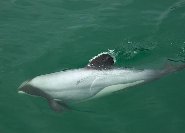 Hector's dolphin (Cephalorhynchus hectori) is a small dolphin species native to New Zealand. Males weigh an average of 40-60 kg (88-132 lbs.) and tend to be between 1.2 and 1.6 meters in length (4-5.25 feet) upon reaching maturity, and the females are only slightly larger. Named for Sir James Hector, the species was first identified and catalogued in 1869. Key features that distinguish it from other dolphins include a distinctly rounded, black dorsal fin and a black crescent-shaped marking between the eyes and blow hole. The animal's short snout, tail, and flippers are also dark in color, its body gray, and the belly is a whitish color.
Hector's dolphin (Cephalorhynchus hectori) is a small dolphin species native to New Zealand. Males weigh an average of 40-60 kg (88-132 lbs.) and tend to be between 1.2 and 1.6 meters in length (4-5.25 feet) upon reaching maturity, and the females are only slightly larger. Named for Sir James Hector, the species was first identified and catalogued in 1869. Key features that distinguish it from other dolphins include a distinctly rounded, black dorsal fin and a black crescent-shaped marking between the eyes and blow hole. The animal's short snout, tail, and flippers are also dark in color, its body gray, and the belly is a whitish color. If you look closely at its sides, a white, almost flame-like pattern can be observed. Hector's dolphins prefer the shallows and are found in the coastal waters of both the North and South islands of New Zealand. The Polynesian Maori, people indigenous to New Zealand, watch the movements of these beautiful sea mammals to gauge the weather. Because of their smaller size, Hector's dolphins eat mainly small, surface schooling fish, although they sometimes dip down lower in the ocean to feed on larger midwater fish and some smaller squid, and its natural predators include several shark species indigenous to New Zealand as well as orca. Like so many of nature's treasures, these animals are currently endangered.
In 1988, the first marine protected area for Hector's dolphins was designated at Banks Peninsula, off of the east coast of the South Island. Since then, a worldwide campaign for awareness and conservation has been launched, and in 2008 the New Zealand Ministry of Fisheries began regulating and banning gill netting in and around known dolphin enclaves. That same year, five new marine mammal sanctuaries were designated, and further restrictions were imposed on local mining and seismic acoustic surveying, industries that also disturb and destroy dolphin habitats.
Picture of the Hector's dolphin by James Shook, licensed under the Creative Commons Attribution 2.5 Generic license.
The Hector's dolphin, new zealand dolphin, white-headed dolphin is listed as Endangered (EN), considered to be facing a very high risk of extinction in the wild, on the IUCN Red List of Threatened Species
Namings for the Hector
A young / baby of a Hector is called a 'calf or pup'. The females are called 'cow' and males 'bull'. A Hector group is called a 'team, school, pod, herd, alliance (male) or party (female)'.Countries
New ZealandSome facts about the
Hector's dolphin
Adult weight : 56 kg (123.2 lbs)
Female maturity :2829 days
Male maturity : 2829 days
Litter size : 1

Custom Search